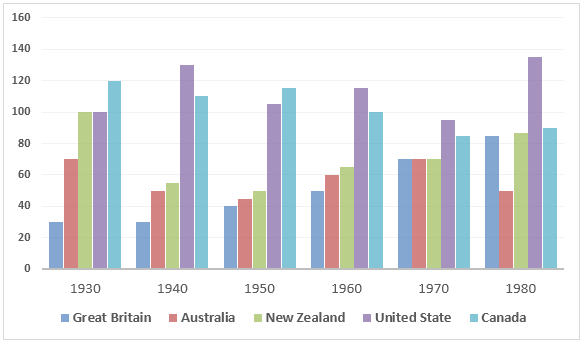» You should spend about 20 minutes on this task.
The table below shows the figures for imprisonment in five countries between 1930 and 1980. Write a report for a university lecturer describing the information shown below.
» You should write at least 150 words.
Figures (in thousand) for imprisonment in five countries between 1930 and 1980.

Sample Answer 1:
The bar graph shows the number of imprisonment in five countries – Britain, Australia, New Zealand, the US and Canada, between 1930 and 1980.
Overall, Canada had the highest number of prisoners in 1930 while Great Britain had the least. But after 50 years, the figure for incarceration decreased in Canada and the United States had the highest number of prisoners.
Initially, in 1930, Canada had 120 thousand prisoners and that was the highest number of inmates among the five countries. There were 100 thousand prisoners both in the US and New Zealand. Again, Australia had around 70 thousand prisoners and Great Britain had only 30 thousand prisoners and that was the lowest. After a decade, the prisoners’ number in Britain remained almost the same while the number decreased in Australia, New Zealand and Canada. But this year the total number of prisoners increased in the US by 30 thousand and reached 130 thousand. In 1950, the prisoners’ number increased in Britain and slightly decreased in Australia and New Zealand. On the other hand, the prisoner in Canada increased and got highest among the five countries and decreased in the US. A similar trend in terms of prisoner numbers in these countries could be observed after a decade. Finally, in 1980, the prisoners’ number in these countries increased except in Australia. The US had the highest number of prisoners this year and Great Britain, Canada and New Zealand had more than 80 thousand prisoners this year.
Sample Answer 2:
The graph presents data on the figures for imprisonment in five countries from 1930 to 1980.
Overall, the data shows considerable fluctuations in the figures for imprisonments in those countries while showing no solid pattern.
In Great Britain, the number of prisoners steadily increased from 30 thousand to over 80 thousand in five decades. It is interesting to note that Great Britain had the lowest imprisonment in 1930, but it was Australia who stood at that position in 1980. On the other hand, the figures in Australia and New Zealand remarkably declined except in 1970. Australia, despite having an imprisonment number of over 70 thousand in 1930, managed to reduce it by 20 thousand in 1980. New Zealand managed to reduce their imprisonment number from 100 thousand in 1930 to half of it in just two decades but again witnessed a steady rise afterwards. The United States had 130 thousand imprisonment number in 1940 and it was slightly higher in 1980. Finally, the imprisonment number in Canada was 120 thousand in 1930, the highest among the given countries, and with some major fluctuations, stayed at 90 thousand in 1980.
Sample Answer 3:
The chart compares the numbers of prisoners from 1930 to 1980 in five different countries, namely Great Britain, Australia, New Zealand, the United States and Canada.
At a glance, the imprisonment figure in the USA and UK climbed over the period and in Canada, Australia, and New Zealand, it actually declined.
It is clearly seen that the United States had the highest number of inmates. Also, Britain had the lowest figure in 4 out of 6 years. In 1930, the number of prisoners in the United States was the highest, with 120 thousand prisoners, then this number increased significantly to reach a peak of 140 thousand in 1980. By contrast, Britain had the lowest figure for prisoners until 1970, then the figure jumped suddenly to reach 90 thousand.
Canada had the highest number of imprisonment in 1930 and 1960 with nearly 140 thousand people each year. In 1970 the number of prisoners in Great Britain, New Zealand and Australia was the same, about 70 thousand people. In 1980, 50 thousand people in New Zealand were put in prison which was the lowest figure this year.
( Written by – Safa Ahmed )
Sample Answer 4:
The bar chart depicts the number of prisoners in thousands, in five different countries, namely Great Britain, Australia, New Zealand, the United States and Canada during a period of 50 years commencing from 1930.
Overall, the graph gives an impression that the incarceration rate in the USA and UK escalated over time while in Canada, Australia, and New Zealand, it actually decreased.
As is evident in the presentation, Great Britain had the lowest number of imprisonment throughout the initial 40 years till 1980. Interestingly, Britain had witnessed a steady growth in figures, which started from around 30000 in the year 1930 and reached around 70000 in the year 1970. By contrast, the United States had the maximum number of criminals throughout the entire span of years except in the first decade, which is 1930. Moreover, in the year 1980, the United States had to imprison the highest number of citizens in the entire period, which accounted for around 130000.
It is apparent from the graph that the crime rate in Canada had fallen gradually and steadily, from 120000 people in 1930 to a significantly less 90000 people in 1980. However, except for the years, 1930 and 1980, Australia had considerably less number of jailing and New Zealand had always positioned as the top three consistently just behind Canada and the United States.
( Written by – Anoop Asokan )
